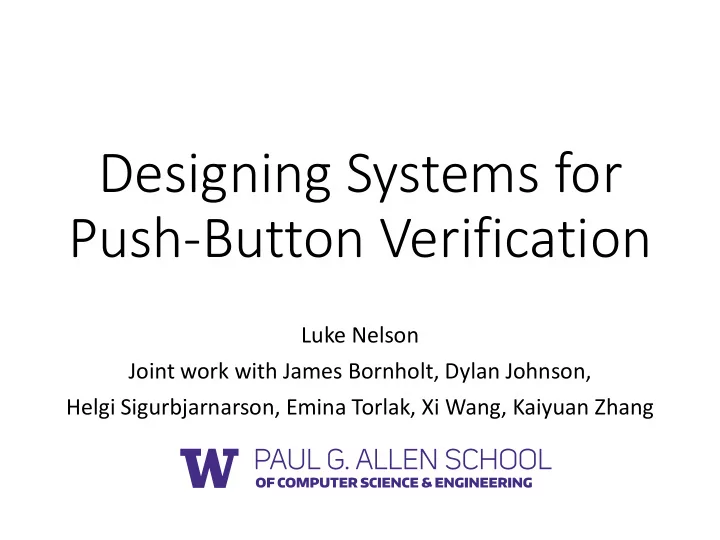

Designing Systems for Push-Button Verification Luke Nelson Joint work with James Bornholt, Dylan Johnson, Helgi Sigurbjarnarson, Emina Torlak, Xi Wang, Kaiyuan Zhang
OSes are everywhere
OSes (& bugs) are everywhere
Goals • Develop “bug-free” systems software • Correctness, performance, and programmability
Formal verification of systems • Eliminate entire classes of bugs • Write a spec & prove impl meets the spec COMPCERT • Verification projects at UW: Bagpipe [OOPSLA’16], Neutrons [CAV’16], Verdi [PLDI’15], …
Challenges 1/3: non-trivial efforts • Time-consuming: often person-years • Require high-level of expertise • Example: the seL4 kernel 10 KLOC code, • • 480 KLOC proof 11 person-years •
Challenges 2/3: spec • What is a correct system • Low-level correctness is well-understood: no overflow • Some fields have been using formal specs: TLA+ • Difficult in general • Examples • The file system must ensure crash safety • The OS kernel must enforce process isolation
Challenges 3/3: integration • Integrating verification with daily development • Learning curve • Write good specs • Improve upon testing (e.g., Driver Verifier) • Catch up with new features: no code base is static • Incremental deployment: co-exist with legacy code
Push-button verification • System design for minimizing proof efforts • Verifiability as a first-class concern • Leverage advances in automated SMT solving
Outline • Yggdrasil [OSDI ‘16]: File system • Hyperkernel [SOSP ’ 17]: OS kernel • Ongoing Work • Conclusion
Approach • Model as event-driven systems • A set of “atomic” handlers • Each handler is bounded • Add layers to scale up verification • Proof automation using SMT solvers • Use effectively decidable theories only (if possible) • Smart encodings of systems properties • Need research on SMT “symbolic” profiling
Yggdrasil [OSDI ‘16] • Yxv6: journaling file system similar to ext3 • Guarantees: functional correctness & crash safety • Verified: 1.6 hours w/ 24 cores - no manual proofs spec impl consistency inv. Yxv6 250 1,500 5 infrastructure -- 1,500 -- FUSE stub -- 250 --
Hyperkernel [SOSP ‘17] • Unix-like teaching operating system based on xv6 • Functional correctness • High-level properties, ex: Process isolation • 15 minutes to verify on an 8-core Intel i7 CPU Component Lines Languages Kernel implementation 7,419 C, assembly Representation invariant 197 C State-machine specification 804 Python Declarative specification 263 Python User-space implementation 10,025 C, assembly Verifier 2,878 C++, python
Ongoing work • Generalize to more systems • Push the boundary to more complex systems • Example: Hypervisors • Deployability • How to use push-button verified systems in practice
Conclusion • Push-button verification • Examples: file systems, OS kernels • Reusable design patterns and toolchains • Verifiability as a first-class design concern • How to integrate with daily development
Recommend
More recommend